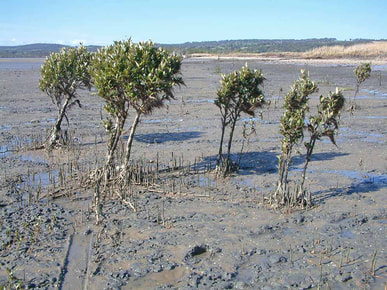 Grand plans for blue carbon sinks in Western Port need to tackle the low success rate of mangrove planting projects. Photo: Neil Daly
Grand plans for blue carbon sinks in Western Port need to tackle the low success rate of mangrove planting projects. Photo: Neil Daly
In my article A chance encounter of the seedling kind, I called for a Western Port Mangrove Restoration Symposium as a matter of urgency as, over the past 20 years or so, many attempts by various agencies to increase the number of mangrove stands in parts of Western Port had failed. I finished by saying the Federal Government and the Victorian State Government should note the situation for until there are many hectares of mangroves growing along the eastern arm of Western Port the blue carbon project in this region will not achieve its intended outcome.
- In response to a letter outlining my concerns, Federal Environment Minister Tanya Plibersek advised me of the Federal Government’s commitment to protecting our coastal ecosystems and the allocation of $30.6 million for “practical action in Australia and the region through the Blue Carbon Conservation, Restoration and Accounting Program”; and
- State Environment Minister Ingrid Stitt indicated the State Government, as part of its program Protecting Victoria’s Environment – Biodiversity 2037, had allocated $700,000 to the Western Port Biosphere Reserve Foundation to “plan for on-ground actions to restore blue carbon ecosystems (mangroves, saltmarsh and seagrass), and to support stakeholder and community engagement”.
- On World Mangrove Day, July 26, in response to the State Government’s call to restore blue carbon ecosystems in Western Port, the Biosphere held the inaugural meeting of the “Blue Carbon Planning in Western Port - Stakeholder Working Group”. Made up of representatives from various stakeholders, the group discussed the aims and broad objectives of the project. Further meetings are planned and the project is due to finish in November 2024.
- On August 9, the State Government announced a second grant of $1.2 million to be shared between the Bisophere and the Bunurong Land Council for planning and restoration projects in the Western Port Biosphere Reserve. The aim of this new project is to “improve its marine ecosystem and its growing potential as a major site for blue carbon capture.” No completion date has been given for this venture.
“Investing in the health of the UNESCO Western Port Biosphere Reserve is crucial to maintaining Victoria’s precious biodiversity for years to come”, Ms Stitt said.
While it’s commendable that the State Government has finally recognised the environmental significance of Western Port, stakeholders must come to terms with the elephant in the room: figuring out how to plant mangroves in sufficient numbers to curb foreshore erosion of up to one metre per year along the eastern arm of Western Port.
The University of Melbourne, Melbourne Water, Deakin University, Bass Coast Landcare Network and the Western Port Seagrass Partnership have all been involved in mangrove planting, with varying degrees of success.
Given this problem continues to drag on and that the Biosphere is now responsible for implementing the State Government’s investment of $1.2 million in these blue carbon projects, it needs to run a Western Port Mangrove Restoration Symposium and settle the matter.
To coincide with the mangrove planting season starting this December, the symposium outcome should be a fully-costed mangrove planting program based on specific goals that are measureable, objective, achievable, relevant and timely.
Failure to achieve this outcome will likely perpetuate the current situation, imbed the high failure rate of mangrove propagation in this region, diminish the effectiveness of the blue carbon projects and pass on the problem to the next generation.
In terms of the overall project, I trust the blue carbon consortium will be able to state the cost-effectiveness of the proposed decarbonising program for there is another elephant waiting in the wings: climate change modelling suggests there will be sea level rise and inundation of low-lying Western Port areas. If so, how will this affect the current projects and is it time to consider the prospect of a government buy-back of coastal land and let nature run its course?
I hope the State Government and those seeking government will take note of the situation, for the issue will last longer that a four-year term in office and will not be solved by perpetuating piecemeal measures.